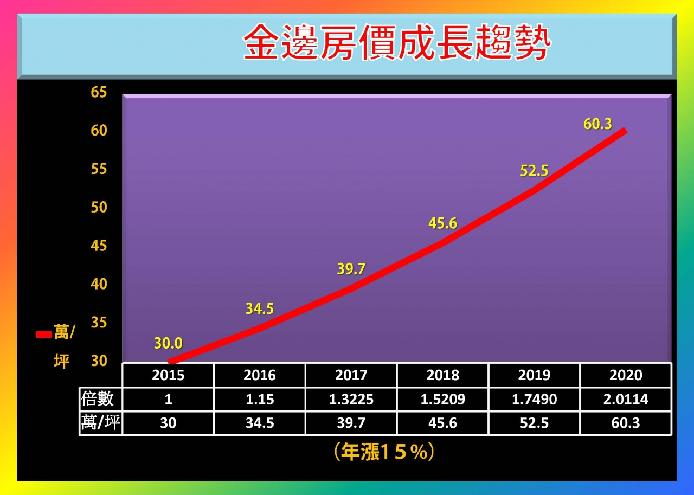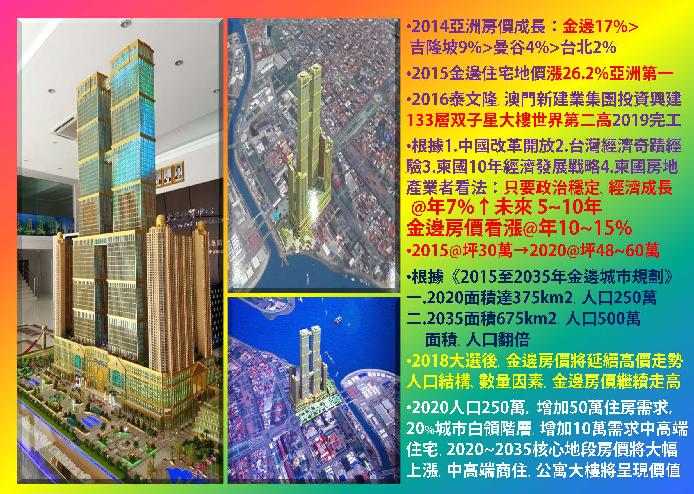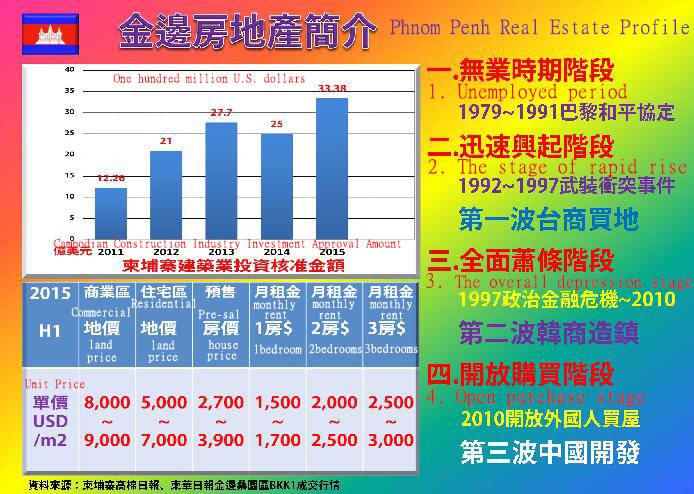
Phnom Penh Real Estate Profile
Four stages of real estate development in Phnom Penh, Cambodia in the past 20 years:
1. Unemployed period: after liberation in 1979 (referring to the Vietnamese army occupying Phnom Penh and the establishment of the Phnom Penh regime) to October 1991 before and after the "Paris Peace Agreement". After 1984, as the situation in Phnom Penh and even Cambodia became more and more stable, people in Phnom Penh began to buy and sell houses. Most of the first wave of buyers were Chinese, but the prices were very cheap.
2. The stage of rapid rise: from 1992 to July 1997 before the armed conflict.
※Armed conflict incident: Refers to the military coup by Hun Sen, then the second prime minister, who overthrew the first prime minister, Prince Ranariddh.
In October 1991, the United Nations mediated and signed the "Paris Peace Agreement" to resolve the Cambodian issue by political means. Tens of thousands of UN peacekeepers and a large number of foreigners entered Cambodia one after another, and real estate prices or house rents reached peaks at that time.
In 1992, the number of peacekeeping troops in Cambodia reached more than 10,000. They rented houses or stayed in hotels with high salaries, which caused real estate prices to soar. The real estate business was booming for a time.
1993 first general election. In August 1994, the "Investment Law" was promulgated to provide a large number of preferential policies for private investment at home and abroad to attract private investment. A large amount of foreign capital poured in, and a large number of businessmen rushed to buy and rent land. The real estate market was booming, reaching its climax in 1995-1996. The real estate output value has been growing at a rate of more than 20% for several consecutive years.
The first wave of Taiwanese businessmen bought land in the 1990s. The land in Phnom Penh was about 1-5 USD/m2, and it rose to about 1500-4000 in 2013.
On the eve of the armed conflict in 1997, a large amount of foreign capital poured in. Many foreign and local businessmen were keen to speculate on land, and real estate prices doubled, extending from the urban area to the suburbs, Sihanoukville, Siem Reap and other places. Due to the establishment of a large number of factories, the prices of large fields in the suburbs have already risen sharply, especially in areas where roads are built or near factory areas. Enjoy the "Generalized System of Preferences" (GSP) treatment given by 28 European and American countries, and more than 200 foreign-invested textile and garment processing factories have sprung up. To meet the needs of tourism development, a large number of hotels were built in Phnom Penh and major tourist areas to promote the development of the real estate industry during this period.
3. The overall depression stage: from the armed conflict in 1997 to the real estate recession in 2010.
Due to domestic political turmoil in 1997, the Asian financial crisis and the second general election in 1998, real estate began to cool down sharply. The developable land in the suburbs of Phnom Penh is limited, and a large number of merchants have undeveloped land. The real estate industry is not favored by the market, and there is a state of "there is no market". The investment environment has not improved, infrastructure construction cannot keep up with the needs of economic development, government corruption and low efficiency have caused a sharp decline in foreign investment year after year. Many foreign businessmen withdrew capital, lacked new foreign investment, and real estate transactions were declining. Phnom Penh or far away from the capital city and rural areas, the real estate industry has entered a period of overall depression.
The second wave of Korean-made town construction in 2000: For example, Furong Group invested 1.13 billion US dollars in Furong City, World City Group Cambodia-Korea City (scheduled to be completed in 2018) invested 2 billion US dollars, Sihanoukville vs Monivong Avenue Gold Tower 42 was suspended due to the financial turmoil. From 2000 to 2013, the country with the most foreign investment in construction and real estate was South Korea, followed by China.
4. Open purchase stage: In 2010, the "Foreigners' Private Property Ownership Law" was passed, allowing foreigners to purchase houses above the second floor. In 2012, foreigners purchased 327 houses, a year-on-year increase of 30-40%. In 2012, foreigners purchased about 1,000 houses.
The third wave of large-scale Chinese investment after 2010: Wangu Lake invested 1.5 billion U.S. dollars, Shuijinghua (Duck Island) invested 1.6 billion U.S. dollars, Diamond Island (Canada Group OCIC Cambodia invested 300 million U.S. dollars and is scheduled to be completed in 2016).
In 2015, the land price of the Wanjinggang 1 sub-division of the Chamyuan District in Phnom Penh was 5,000~7,000 USD/m2, and the land price of the Sihanoukville VS Monivong Avenue commercial area was 8,000~9,000 USD/m2. The pre-sale price of BKK1 is 2,700~3,900 USD/m2. The supply of rental buildings is in short supply. According to the field survey, the monthly rent in BKK is 1,500~1,700 USD for 1 bedroom, 2,000~2,500 USD for 2 bedrooms, and 2,500~3,000 USD for 3 bedrooms.
Source: Nanning Economic Information Network 2011-05-04
Cambodian Khmer Daily, Cambodian Chinese Daily |






 .......热点省份代理人 詹经理 Rock Chan
.......热点省份代理人 詹经理 Rock Chan